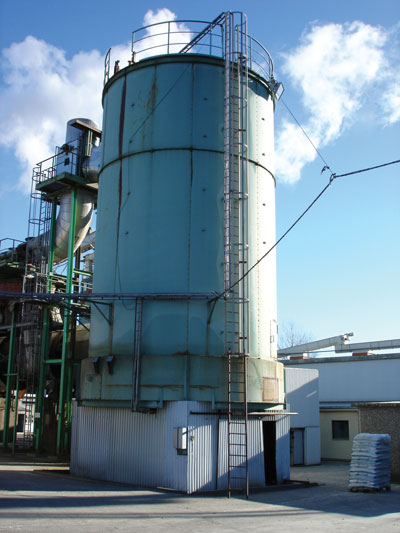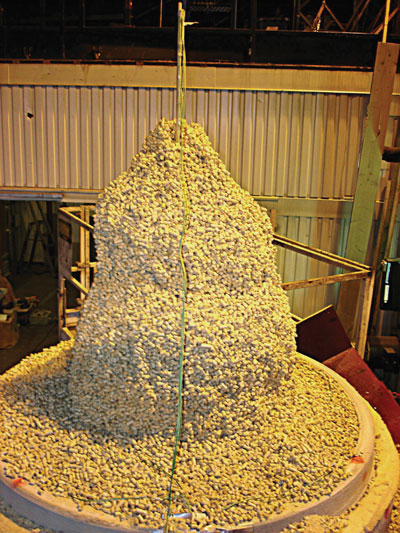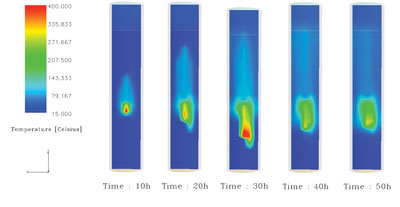
Responding Safely to Silo Fires
December 5, 2011
By Henry Persson
In the past 10 years, the use of solid biofuels, and in particular wood pellets, has increased dramatically.
In the past 10 years, the use of solid biofuels, and in particular wood pellets, has increased dramatically. In year 2000, the annual production of wood pellets in Europe and North America was about 1.5 million tons, while the expected production for 2010 was in the range of 16 million. Sweden is the largest wood pellet consumer with a consumption of about 2.3 million tons in 2010. The production of wood pellets in Sweden was only about 1.65 million tons, with the remaining imported by ships, normally from North America and the Baltic states. However, pellet consumption is increasing dramatically in several other European countries, and as a consequence, handling and storage of wood pellets is also escalating.
 |
|
| During the gas distribution tests, a 300 m3 empty test silo was used to monitor only the filling time of the gas.
|
In order to improve our knowledge of fire development, detection and extinction techniques in silos, two main test series have been conducted at SP Technical Research Institute of Sweden, and they are described below. Experience from these projects has resulted in recommendations concerning proper extinguishing practices.
Silo extinguishing tests
The main purpose of the first project conducted in 2006 was to study fire extinction techniques in silos and provide guidelines concerning the tactics used. The project also provided valuable information about initial fire development from a simulated spontaneous ignition in the stored material and the possibility for early detection.

|
|
| After the tests were concluded, researchers found that the pellets formed a congealed pile in the top part of the silo and noted that the pyrolysis zone was about 0.5 metres below the ignition source.
|
The silo used for the test was one metre in diameter and six metres high. A ventilation duct was installed close to the base of the silo, which was used to provide ventilation to the silo during the “pre-burn” phase and for injection of inert gas during the extinguishing phase. The silo was filled with wood pellets up to a height of five metres during the tests. Local auto-ignition was simulated using a coiled heating wire placed in the pellets, located centrally in the silo.
In these tests, the extension of the pyrolysis zone was mainly downwards, towards the air inlet, while a heat/moisture wave with a temperature less than 100 C, slowly moved upwards, seen above. Although the distance from the point of ignition to the pellet surface was only about 2.5 metres, it took around 20 hours before the fire could be detected by gas analysis located in the top of the silo, clearly indicating the problems of early fire detection of smouldering fires in silos.
Gas filling tests
The purpose of the second project, conducted in 2008, was to investigate how nitrogen should be injected into a real silo during extinction to achieve optimal gas distribution. The experiments were performed in a 300 m3 steel silo with a diameter of six metres, a height of 10.5 metres and filled with about 260 m3 of wood pellets. In total, five tests were conducted where the gas was injected from the centre of the base of the silo, or alternatively, at one point along the silo wall. All tests were conducted in a “cold” silo (no fire), as the main focus was to study the gas distribution in the material. The tests showed that the gas distribution was significantly influenced by the gas flow rate, the location of the inlet and the properties of the bulk, showing the need for several distributed gas inlets when using large-diameter silos.
Experience from fire incidents
The results from the first silo project have been applied successfully to several real silo fires in Sweden. In one incident, auto-ignition occurred in a silo 47 metres high and eight metres in diameter and filled to about 40 metres with wood pellets. Elevated temperatures had been noted for some time and it was planned to empty the silo within the next few days.
However, before such action could be taken, smoke was seen emerging from the top of the silo and the fire brigade was called. Initially, extinction was attempted using the application of liquid CO2 to the top volume of the silo. Approximately 35 tons of CO2 were applied intermittently over a period of approximately 18 hours. The application seemed to control the fire, but it was not possible to verify how much of the gas penetrated into the bulk. Consequently, it was not possible to determine when a discharge operation could be safely started.
Therefore, nitrogen was injected close to the silo base according to the recommendations from the experiments in 2006. In order to control the effect of the gas injection, temperatures and concentrations of CO, CO2 and O2 were measured in the top of the silo. In total, nitrogen injection continued for almost 65 hours without interruption until the silo content was discharged. Approximately 14 tons of nitrogen was used, which gives a total gas consumption of approximately 5.6 kg/m3, well in line with the recommendations from the research project.
 |
|
| During the first tests, temperature variations within the silo continued for more than 40 hours. |
Summarized guidelines
Based on both the results of the research projects and practical experience of real silo fires, the following recommendations are given:
- Make an initial risk assessment of the situation. Concentrations of carbon monoxide in indoor areas in the vicinity of the silo may be dangerously high. Further, consider the risk of dust and gas explosions in the silo and associated systems.
- Close all openings to the silo and turn off ventilation, so that air into the silo is minimized. A release hatch or similar device for gas and pressure relief should be present while still preventing any inflow of air.
- Inject nitrogen close to the bottom of the silo. A large-diameter silo will require several gas inlets. The nitrogen should be injected in gaseous phase, and an evaporator must be used. Assume an injection rate of 5 kg/m2 hour (cross-sectional area) and a total gas consumption of 5-15 kg/m3 (gross volume) of the silo.
- If possible, measure the concentration of CO and O2 at the top of the silo during the entire extinguishing and discharge operation.
- Do not begin discharging the silo until there are clear signs (low levels of CO and O2) that the fire is under control.
- Be aware that the discharge capacity might be considerably reduced compared to that available in a normal situation, and that the operation might take several days to complete.
- The discharged pellets must be inspected for glowing or burning material and extinguished using water if necessary.
- The gas injection should continue during the entire discharge process.
Important to remember!
- Do not open the silo during the firefighting operation. This will cause air entrainment, which will increase the fire intensity and might cause dust and gas explosions and an escalation of the fire situation.
- Do not use water inside a silo filled with wood pellets. Water application will cause considerable swelling of the pellets which could both damage the silo construction and cause significant problems for the discharge operation.

|
Henry Persson is working as a project leader at the Fire Dynamics section at SP, the Swedish Technical Research Institute, mainly with testing and research in the areas of fire protection, fire extinguishing systems and extinguishing media. He has been working at SP since 1979 and is actively participating in the International and European standardization work as the principal Swedish expert. He also chairs the ISO group for firefighting foams, ISO TC21/SC6/WG4 and has been project leader for a large number of BRANDFORSK projects. He also was the project leader at SP for the EU foam research project FOAMSPEX and has been participating in several other EU projects.
Print this page